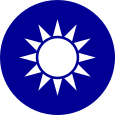Four-Stage Theory of the Republic of China
| Four-Stage Theory of the Republic of China | |
|---|---|
Hanyu Pinyin | Zhōnghuá Mínguó Sì Jiēduàn Lùn |
| Southern Min | |
| Hokkien POJ | Tiong-hoâ Bîn-kok Sì Kai-toāⁿ Lūn |
The Four-Stage Theory of the
- The Republic of China on the mainland (中華民國在大陸; Zhōnghuá Mínguó zài Dàlù), 1912–1949
- The Republic of China arrival to Taiwan (中華民國來臺灣; Zhōnghuá Mínguó lái Táiwān), 1949–1988, before Lee Teng-hui's presidency
- The Republic of China on Taiwan (中華民國在臺灣; Zhōnghuá Mínguó zài Táiwān), 1988–2000, during Lee Teng-hui's presidency
- The Republic of China is Taiwan (中華民國是臺灣; Zhōnghuá Mínguó shì Táiwān), 2000–now, during Chen Shui-bian's presidency[1][2][3]
Illumination
By this
Development
Both the
The Democratic Progressive Party's 1999 Resolution on Taiwan's Future, which is accorded equivalent status as the Party charter, serves as the baseline of debates toward the "status quo". According to the 1999 Resolution: "Taiwan is a sovereign and independent state and that its national title is the ROC." In other words, "Taiwan is the ROC".[17]
During the Democratic Progressive Party (DPP) administration under Chen Shui-bian, he directed that all government publications and websites to use the form "Republic of China (Taiwan)." These two variations have been used under their respective administrations for the ROC/Taiwan petition to join the United Nations. Unlike the Cold War era when the KMT-controlled ROC competed with the PRC as the legitimate representative of China (including Taiwan), during Chen Shui-bian's presidency, the ROC did not seek to be the representative of China (i.e. it does not seek the PRC's seat on the Security Council or its ouster) and stresses in its petitions that it was only seeking to represent the people of the land under its effective control (i.e. UN's principle of universality).[4]
On October 8, 2011, the eve of the centennial celebration of the founding of the Republic of China on
Historian Chen Yi-shen said "many are aware that the ROC and Taiwan are two faces of the same coin" and Tsai's ROC was an extension of the ROC from former presidents Lee Teng-hui and Chen Shui-bian. While some understood "elections have their own languages", many Taiwanese, including former DPP Chairman and former president of the Examination Yuan Yao Chia-wen, are absolutely against the ROC and insist "we need to promote the rectification our nation's name to the Republic of Taiwan".[19]
Tsai won
See also
References
- ^ Mainland Policy and Work - August 2, 2005, Mainland Affairs Council, 2005
- ^ a b Chen says name variance is simply an expedient, Taipei Times, 2005/8/3
- ^ a b Chen urges unity to deal with China, Taipei Times, 2005/8/3
- ^ a b c International Business Publications, USA, Position of the Republic of China (ROC), Taiwan Country Study Guide: Strategic Information and Developments, 2012/3/3, p45
- ^ "Democracy's coming of age". Free China Journal/Taiwan Today. 1 December 1981. Retrieved 21 June 2017.
- ^ "Helping hands for reconstruction". Free China Journal/Taiwan Today. 1 September 1980. Retrieved 21 June 2017.
- ^ "Double Tenth of confidence". Free China Journal/Taiwan Today. 1 November 1977. Retrieved 21 June 2017.
- ^ "The Month in Free China". Free China Journal/Taiwan Today. 1 June 1967. Retrieved 21 June 2017.
- ^ "Documents". Free China Journal/Taiwan Today. 1 August 1958. Retrieved 21 June 2017.
- ^ "Reaping Ideas And Criticism". Free China Journal/Taiwan Today. 1 October 1988. Retrieved 21 June 2017.
- ^ "'Please call me Mr. Ching-kuo'". Free China Journal/Taiwan Today. 1 February 1989. Retrieved 21 June 2017.
- ^ "Perceptions And Realities". Free China Journal/Taiwan Today. 1 May 1989. Retrieved 21 June 2017.
- ^ "Redefining Social Order". Free China Journal/Taiwan Today. 1 October 1988. Retrieved 21 June 2017.
- ^ "Taiwan Review". Free China Journal/Taiwan Today. 1 February 1990. Retrieved 21 June 2017.
- ^ Text of Lee's Cornell address Archived 2016-10-30 at the Wayback Machine, TAIWAN INFO, Ministry of Foreign Affairs, 1995-6-16
- ^ 國家定位 李前總統︰ROC在台灣, TVBS, 2003/12/21
- ^ a b DPP’s Cross-Strait Policy Consistent with “Status Quo”, Jamestown Foundation, 2011/12/20
- ^ Tsai presents “ROC is Taiwan” stance on eve of centenary, Formosa News, 2011/10/09
- ^ a b Tsai affirms recognition of the ROC, Taipei Times, 2011/10/10
- Peter Kien-Hong Yu, Chapter 5: The LEE Teng-hui March: A Zig-Zag Line / Chapter 6: The CHEN Shui-bian March: A Forced, Untrodden Split Line with Sideroads, The Second Long March: Struggling Against the Chinese Communists Under the Republic of China (Taiwan) Constitution, 2011/11/3



